
Welcome to my spring crochet-along! As you know from my previous blog post, I’ve been designing a granny square bag.
During lockdown in the UK, I’ve been finalising the pattern and now that our lockdown has been extended, I thought I’d publish it in sections, so that everyone can complete the Crochet-along with me, and have a bag by the time we’re allowed out again! If you’re an experienced crocheter and just want to head straight to the standard written pattern, head here but if you’d like to know a bit about the bag first, or if you’re less experienced or you’d like more detailed instructions with pictures, read on…
Construction and materials
The bag is made up of two large squares, 6 smaller squares, two side strips, a long strip for the gusset and a number of small squares for the handle…
Here’s the first one I made…

You can make it in any DK yarn – I’ve done versions in Deramores Studio DK which is now available from Lovecrafts.com – there are some lovely bright and jewel-like colours in their range, and it’s not expensive either.

Here’s a selection of the Deramores yarn in more muted colours.
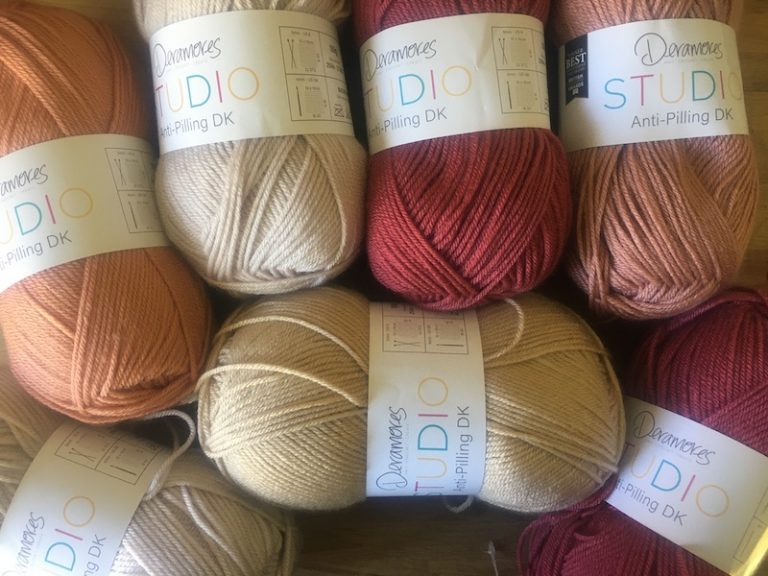
Or how about making it in really zingy colours, like these from the Stylecraft DK range? You can find a wide selection of colour packs of Stylecraft from lincolnwoolpack.co.uk which works out even cheaper.

I’ve also made it in the gorgeous Erika Knight Gossypium cotton, so soft and in lovely, muted colours. I just happened to have a range of colours in my stash, and was pleased to finally find a use for them – this is what was left after I’d made the bag.

This is what my second version turned out like…

I eventually decided to go with a crochet hook a size smaller than I normally use for DK – 3mm – from my favourite Knitpro Waves hook set. This gave a firmer texture to the pieces, and gave the bag a bit more structure. You may find that the yarn you choose may work better with a 3.5mm hook – either is fine.

In the cotton on the smaller hook, I used six colours, with each using under 50g, though you can use as many or as few colours as you like. Even using a slightly larger hook and the Deramores DK, the project still used under 200g in total.
Making a start on the crochet-along
First of all, I’ll explain all the abbreviations that will be used in the pattern. All instructions are in UK terminology. Don’t forget, if you’d prefer just to follow the standard written instructions, you’ll find those here .
Crochet-along Abbreviations
Don’t forget, you start with a slip knot to make the first loop on your hook. See here if you’re not sure how to make one.
Also, when joining in a new colour, simply put your hook through the space or stitch indicated wrap the yarn round the hook at the back of the work, then bring the hook to the front, and work 1 chain stitch [doesn’t count as one of your stitches] to anchor the new yarn. If you can, try to work over the ends of the yarn as you join each new colour in, and there’ll be a lot fewer ends to darn in later. Now you’re ready to follow the instructions for the round.
ch = chain stitch – the basic stitch which looks exactly like its name. Just yarn over and pull through the loop – voila – one chain stitch!
dc = double crochet – for this you insert your hook through the top of the stitch on the row below or through a chain space as instructed in the pattern, yarn over and bring the hook back to the front (2 loops on hook), yarn over and draw it through both loops.
htr = half treble – for this you need to put the yarn over the hook before you insert it through the top of a stitch on the row below or into a space, then yarn over and bring the hook back to the front (3 loops on hook), now yarn over and draw it through all three loops at once.
tr = treble – this one is slightly taller than the half treble. Put yarn over the hook, insert it though the top of a stitch or a into a space, yarn over and bring the hook back to the front (3 loops) – this time yarn over and draw it through the first 2 loops, yarn over again and draw it through the remaining 2 loops.
dtr = double treble – guess what! This is even taller than the treble – yarn over the hook twice, hook through top of stitch or into space, yarn over and bring hook back to the front (4 loops on hook), yarn over and through 2 loops, yarn over and through the next 2 loops, finally yarn over and through the remaining 2 loops. Phew!
Here’s a picture so you can see the different heights of the stitches – double crochet in red, half treble in yellow, treble in dark teal and double treble in pink.

tr2tog = treble 2 together – yarn over, hook through stitch or into space and yarn over, bring hook back to front (3 loops on hook), yarn over and draw through 2 loops (2 loops on hook), yarn over and hook through stitch or chain space as directed, bring hook back to front again (4 loops on hook), yarn over and draw through 2 loops (3 loops on hook), yarn over and draw through all 3 loops, leaving just one loop on hook.
3tr-cluster = 3 treble cluster – the most complicated one, but not difficult if you follow the steps. Yarn over, hook through stitch or into chain space and yarn over, bring hook back to front (3 loops on hook), yarn over and draw through 2 loops (2 loops on hook), yarn over and hook through same stitch or chain space as before, bring hook back to front again (4 loops on hook), yarn over and draw through 2 loops (3 loops on hook), yarn over, hook through same stitch or chain space, yarn over and bring hook back to the front again (5 loops on hook), yarn over and draw through 2 loops (4 loops on hook), finally yarn over and draw through all 4 loops, so you’re back to 1 loop.
rem = remaining – this is easier and self explanatory.
sp = space – so is this, but it could refer to a ch-sp ie a space created by one or more chain stitches on the row below, or it could be through the space between two stitches on the row below. It’ll tell you which in the pattern.
ss = slip stitch – finally, slip stitch which is a useful joining stitch at the end of rows, or sometimes helps to create shapes like the petals. Just put your hook through a stitch or into a space, yarn over and bring the hook back to the front and straight through the loop on your hook.
Just a quick note, it’s useful if you know how to start using a magic circle, however if you don’t, you can work a few chain stitches and join them into a circle with a slip stitch. The magic circle works best, though, as you can tighten up the centre of the motif…
Here’s what the first round looks like with circle of 4 chain stitches to start, and with a magic circle… You can see the magic circle can be tightened up in the middle, so there is no hole.

So, let’s pick up our hooks and get going. And don’t forget, if you get stuck at any point, just get in touch with me by email on facebook or instagram or in a comment here, and I’ll try to help you.
Here we go
We’ll make a start on the main square which actually starts off as a circle! It doesn’t turn into a square until Round 7 so today, you’ll end up with a circle. For this first part of the crochet along, we’ll just work up to Round 6, and you can make two of these circles – they don’t even have to match if you don’t want them to – that way your bag will look different depending on which side you choose to have facing outwards. Don’t forget, if you just want the pattern in normal crochet terminology, see here.
MAIN SQUARE (you’ll need to make 2 of these)
Round 1: If you don’t know how to do a magic circle, make 5 chain stitches and join them into a ring with a slip stitch.

Or start with a magic circle… Now work 4 chain stitches [this counts as a treble stitch plus 1 chain stitch].

Now working into the centre of the ring or the magic circle, whichever you’re using, work 1 treble and
1 chain seven times, and join with a slip stitch to the third of the chain stitches you made at the beginning.
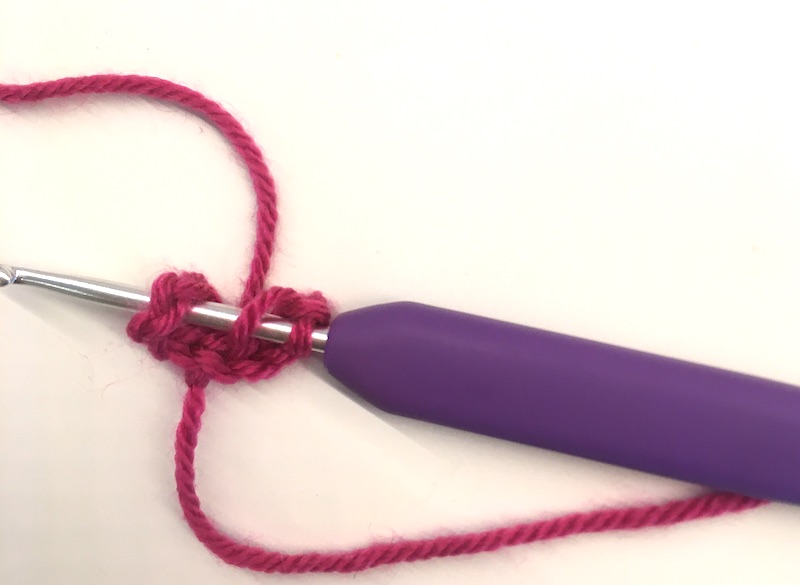


Fasten off this colour. You now have a circle of trebles with a space between each – almost like a wheel with 8 spokes, though the spokes will only become much more apparent after you make the next round…
Now to make the petals…
Round 2: Join the next colour of yarn into one of the one-chain spaces, and work 2 chain stitches, then in the same one-chain space work 1 treble, 1 double treble, 1 treble, and 2 chain stitches and slip stitch into the space again – you should now have one petal. Work one chain stitch. Here’s that bit broken down in pictures…
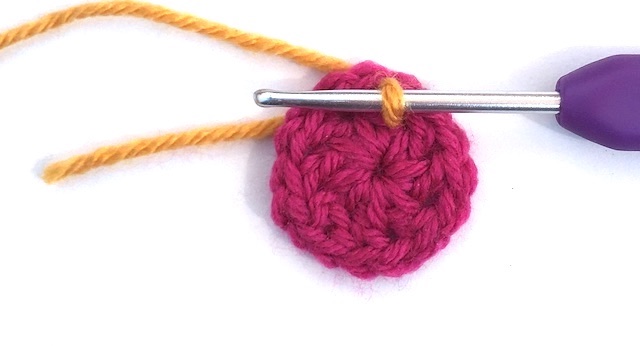


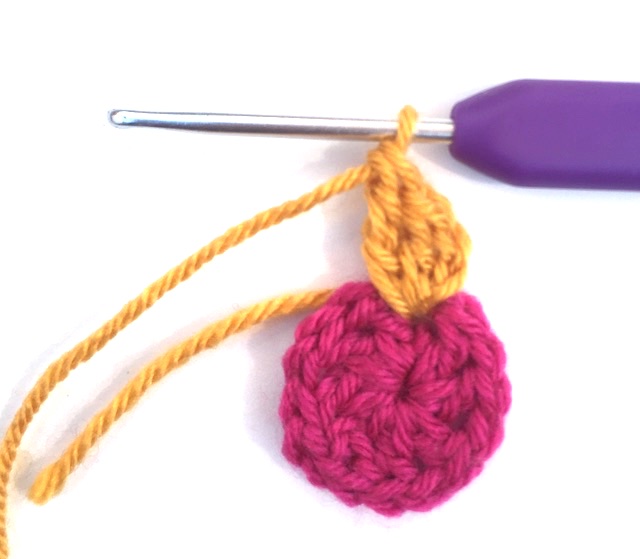

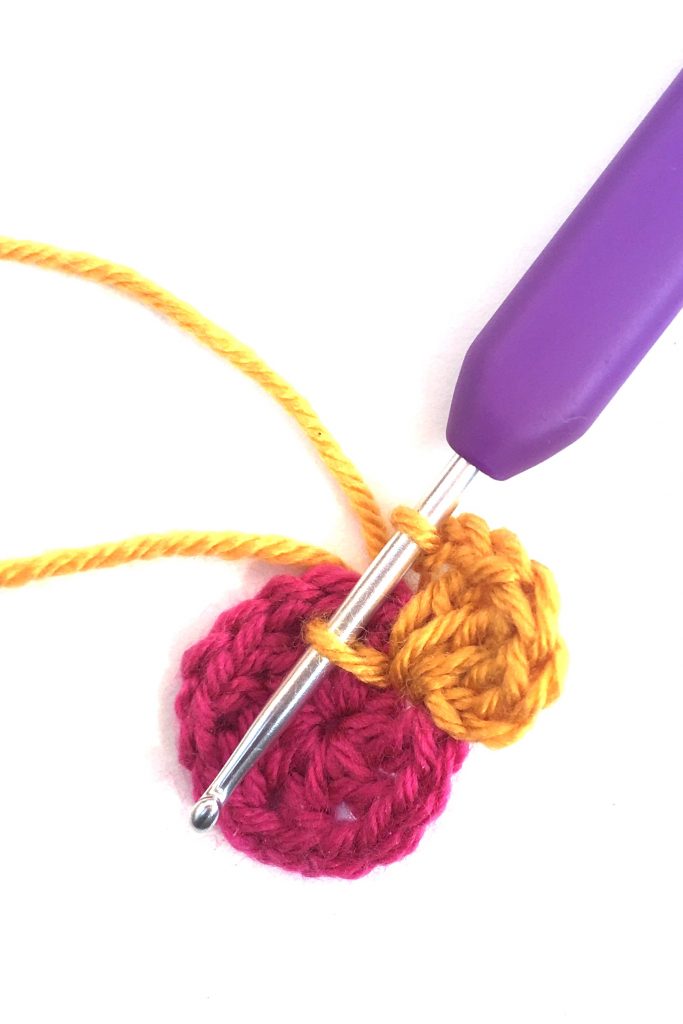

Now make a petal in the next space as before – ss, 2ch, 1tr, 1dtr, 1tr, 2ch, ss into same 1ch-sp, and finish with 1ch – repeat this 6 times more, then make one last chain and slip stitch into the initial space, right next to the first petal. You should have ended up with 8 petals. You should now also see the wheel with spokes effect! Do not fasten off here.

Round 3: Continue in the same colour and make 3 chain stitches – these now have to sit behind the petal, and then make a double crochet in the 1-chain space between this petal and the next. It may be easier if you bend the petal forwards each time so that you can see what you’re doing. Repeat this seven times more, then join with a slip stitch to the first chain you made and you should end up with 8 petals in a circle. Fasten off this colour.
(I’m actually using a different colour in the following picture and have turned the motif round after I finished the round, so that you can see where the chain stitches sit – this is the back of the motif).

Round 4: Join a new colour of yarn into one of the 3-chain spaces, and work 3 chain stitches – which counts as a treble stitch here,

now treble 2 stitches together (see the abbreviations if you don’t know how to do this),



work 2 chain stitches then a 3treble-cluster (again, instructions above in the abbreviations),



*1 chain stitch, then in next 3-chain space, work a 3tr-cluster, 2ch, 3tr-cluster. Now repeat from the * 6 times, finally finishing with 1 chain and a slip stitch to the 3rd chain you made at the beginning of the round. Fasten off.
It should look like this…

Now for two more rounds…
Round 5: Join yarn in one of the 2-chain spaces [the 2-chain space is the one between 2 treble clusters] and work 4 chain stitches [this counts as a double crochet and 3 chain stitches] , then a dc in the same space. Now a bit that you need to repeat seven times: work 2 chain, double crochet in the 1-chain sp, 2 chain, double crochet in next 2-chain space, 3 chain, double crochet in the same 2-chain space. Once you’ve done all that seven times, to finish off the round, work 2 chain, a double crochet in the 1-chain space, 2 chain, then finally join with a slip stitch to the first chain you made. Fasten off.


Round 6: Join yarn in a 3-chain space [ie one of the pointy bits] and work 1 chain [counts as a dc], a half treble, a treble, a half treble and a double crochet.
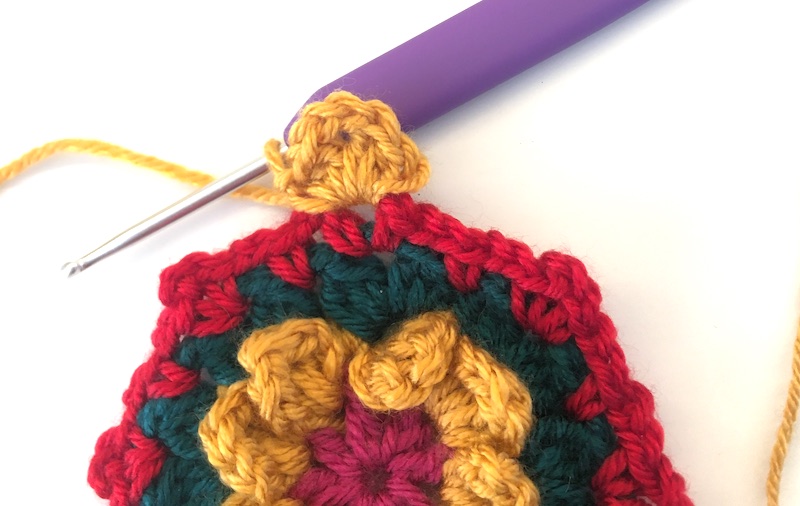
Now a bit to repeat seven times: work 2 double crochet in the next 2-chain space, and 2dc in the next 2ch-sp, in next 3-chain space, work a double crochet, a half treble, a treble, a half treble, a double crochet. After you’ve done all this 7 times work 2 double crochet in the next 2-chain space, and 2dc in the next 2ch-sp. Now join with a slip stitch to the first chain. Fasten off.

That’s it for this part. So get going with your crochet hook today! And now see here for Part 2.
And don’t forget to use the tag #springbagCAL on instagram or facebook to share your version
